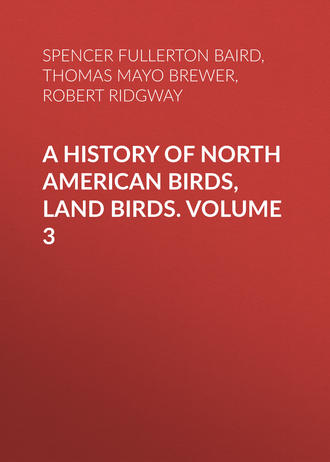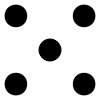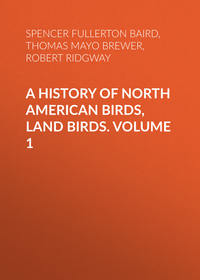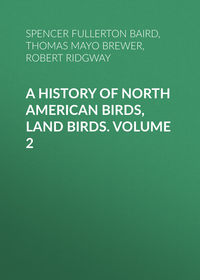 полная версия
полная версияA History of North American Birds, Land Birds. Volume 3
Pes´sulus, n. Cross-bone of the syrinx; bony bar across lower end of windpipe, at point of forking into the bronchi.
Petro´sal, a. (Used substantively.) Same as petrous.
Pe´trous, a. Stony; hence, hard. The petrous bone is an element of the temporal bone.
Pha´lanx, n.; pl. phalan´ges. Commonly any bone of a finger or toe. Equivalent to internode or joint (not articulation). Properly in such application lacking the singular number, phalanges being the row or series of the small digital bones, taken collectively. (120.)
Pharynge´al, a. Pertaining to the pharynx.
Phar´ynx, n. Back compartment of the mouth, leading directly into the œsophagus.
Phren´ic, n. Pertaining to the diaphragm.
Phys´ical, a. Bodily; material. Opposed to mental or psychical.
Physiog´nomy, n. Countenance, in respect to temper of mind; general appearance, in respect to habits.
Physiol´ogy, n. Science of animal or vegetable economy; science of bodily functions, processes, operations. It is less comprehensive than biology, or the science of life, as it takes account only of material or physical, not psychical, offices.
Pi´a Ma´ter, n. Soft vascular membrane immediately investing the brain.
Pi´cine, a. Woodpecker-like.
Pictu´ra, n. Pattern of coloring.
Pig´ment, n. Coloring-matter.
Pil´eus (also written pileum), n. The cap; top of head from base of bill to nape. (30.)
Pin´eal Body, n. A small organ associated with the brain.
Pin´ion, n. Part of the wing beyond the wrist exclusive of the feathers; usually the metacarpus and phalanges; the hand bone. Not technically used synonymously with quill or wing.
Pin´nated, a. Having little wing-like tufts of feathers on the neck.
Pin´niform, a. An epithet of the penguin’s wing; fin-like.
Pisciv´orous, a. Fish-eating.
Pitu´itary, a. That secretes mucus. Pituitary membrane, the mucous membrane of the nasal passages. Pituitary gland, a certain appendage of the brain.
Pla´ga, n. Stripe of color.
Plan´ta, a. Back of tarsus, homologically the sole. (106.)
Plan´tar, a. Pertaining to the sole. A certain muscle is the plantaris.
Plan´tigrade, a. Walking on the back of the tarsus as well as on the soles of the toes. Many pygopodous birds are plantigrade.
Plas´ma, n. Colorless fluid of the blood.
Plas´tic, a. That may be moulded. Forming or serving to form; histogenetic. Plastic force. See Nisus Formativus.
Pleu´ra, n. Membrane lining the thorax and investing the lungs.
Pleurapoph´ysis, n. Segment of the hæmal arch next to the centrum. The vertebral rib of a bird is a pleurapophysis.
Plex´us, n. Union in network of nerves, vessels, or fibres. Said especially of the anastomosis of nerves.
Pli´ca Ala´ris, or Pli´ca Preala´ris, n. The feathered fold of skin on the front border of the wing stretched by an elastic tendon from the shoulder to the wrist, rendering the smooth straight anterior border of the wing. (Plica alaris is rarely used for the fold or bend of the wing.)
Pli´ca Interdigita´lis, n. Webbing between the toes. Same as palama.
Pli´cæ Primiti´væ, n. pl. Primitive folds; certain parallel lines observed in the early embryonal trace.
Plu´ma, n. A feather in general. Compare Penna and Plumula. (1.) A feather of which the two webs are equal and alike is called isopogonous: otherwise anisopogonous.
Plu´mage, n. The feathers, collectively; Ptilosis (which see).
Plum´beous, a. Having the color of tarnished lead; dull bluish-gray.
Plum´iped, a. Having the feet feathered.
Plu´mose, Plu´mous, a. Feathery; in general, having feathers; feathered. Compare Pennaceous and Plumulaceous.
Plu´mula, n. A down feather, lacking certain qualities and parts of a penna.
Plumula´ceous, n. Downy. Compare Pennaceous.
Pneumat´ic, a. Relating to the respiratory system; permeated with air.
Pneumogas´tric, a. Pertaining to lungs and belly; a name of the most extensive cranial nerve.
Podarth´rum, n. Foot-joint; the articulation of the toes collectively with the metatarsus. (100.)
Po´dium, n. Foot. (Same as pes.) Generally used, however, for the toes collectively without the shank. (112.)
Podothe´ca, n. Whole envelope of tarsus and toes. (101.)
Pogo´nium, n.; pl. pogonia. Web or vanes of a feather. (147.) Pogonium externum, outer web (farthest from middle line of the body). Pogonium internum, inner web. See Pluma.
Pol´lex, n. Thumb. The joint which bears the alula is so called, though it is homologous with the index or second finger. Spina pollicaris, or Tuberculum pollicare, the horny spur on the wing of some birds.
Polyg´amous, a. Mating with more than one female, like the domestic cock.
Polymor´phic, n. Of many forms; consisting of, or containing, several different types of structure: as, a polymorphic group.
Polymy´oid, a. Having numerous syringeal muscles; noting a group equivalent to Oscines.
Polyno´mial, n. or a. Name of more than two words. Consisting of several words. The polynomial nomenclature is obsolete.
Polyto´kous, a. Multiparous; producing many young.
Pons, n. Bridge. Certain parts of the brain.
Poplite´al, a. Pertaining to the back of the knee.
Por´tal Circula´tion. Passage of blood from the capillaries of one organ to those of another, as is conspicuous in certain of the digestive viscera.
Postax´ial, a. Situate on the external or posterior (ulnar or fibular) side of a limb.
Poste´rior Portion. (8.) See Uræum.
Posterior Toe. (125.) The hind-toe, or that one directed backward, is generally the hallux; often also the fourth or outer; rarely the second or inner. The hallux is generally meant by posterior toe.
Postor´bital, a. Situate behind the eye.
Pow´der-down Feath´ers, n. pl. Peculiar imperfect feathers, in a matted patch, which grow continually, and as constantly break down, with a scurfy exfoliation, and pervaded with a greasy substance; they are especially conspicuous in the heron tribe, but are also found elsewhere.
Præax´ial, a. Situate on the internal or anterior (radial or tibial) side of a limb.
Præco´ces, n. pl. An obsolete group of birds, able to run about and feed themselves at birth.
Præco´cial, n. Belonging to the Præcoces; having the nature of Præcoces.
Præpec´tus, n. Fore-breast; region of the craw. Not well distinguished from jugulum.
Premax´illary (bone), a. The foremost and principal bone of the upper jaw. Intermaxillary is synonymous.
Prep´uce, n. Foreskin. The homologous structure occurs in some birds. Preputial, pertaining to the foreskin.
Pressiros´tral, a. Having a bill like that of a plover. (Obsolete.)
Prester´num, n. Anterior segment of the breast-bone.
Pri´mary, n.; pl. primaries. Any one of the (usually ten, often nine, rarely eleven) large stiff quills growing upon the pinion or hand-bone, as distinguished from the secondaries which grow upon the forearm. They form the tip of the wing, and much of its surface.
Pri´mary Wing-coverts, n. pl. Those overlying the bases of the primaries.
Proce´res or Pro´ceri, n. pl. Same as Ratitæ (which see).
Prolig´erous, a. See Yolk.
Prona´tion, n. A particular movement of the radius upon the ulna, by which the hand turns over,—in birds it is very slight, if it occur at all. The reverse movement is termed supination. The muscles effecting it are pronators and supinators.
Proöt´ic, a. for n. An element of the auditory capsule.
Prosenceph´alon, n. A certain tract of the brain, the third from behind.
Pro´toplasm, n. Primitive common embryonic tissue, out of which different organs and parts are formed.
Protover´tebræ, n. pl. First trace of the backbones.
Protrac´tile, Protru´sile, a. Susceptible of being thrust forward or out, as the tongue of most woodpeckers.
Proventric´ulus, n. Part of gullet, usually enlarged, next to gizzard, having solvent glands for digestion. It is the true stomach of a bird, as distinguished from the gizzard or grinding stomach.
Prox´imal, a. Proximate; nearest or next to any centre or axis. Opposed to distal or terminal.
Psilopæ´des, n. pl. A group of psilopædic birds, further distinguished by being born weak and helpless, fed and reared in the nest. The term gymnopædes is synonymous.
Psilopæ´dic, a. Having down growing only from the future pterylæ, as the precursor of the future plumage, to which it is subsequently affixed for a while and then falls off.
Pso´as, n. Name of certain pelvic muscles.
Pterapoph´ysis, n. Certain process of cranial bones.
Pter´na, n. Heel-pad. (115.)
Ptero´mata, n. pl. (This word is of uncertain meaning.) (89 ?)
Pter´ygoid (bone), n. A slender bone connecting the quadrate with the palatine.
Pter´yla, n.; pl. pterylæ. Area or tract on the skin where feathers grow.
Pterylog´raphy, n. A description of the plumage, especially with reference to the distribution of the feathers on the skin.
Pterylo´sis, n. Plumage, considered with reference to its distribution on the skin.
Pti´la, n. (This word is of uncertain meaning.) (86 ?)
Ptilopæ´des, n. pl. Ptilopædic birds. Such are generally able to run about at birth, or at least to feed themselves. Dasypædes is synonymous.
Ptilopæ´dic, a. Clothed at birth with floccus, which sprouts not only from the future pterylæ, but also from apteria.
Ptilo´sis, n. Plumage. (3.)
Pu´bic, a. Pertaining to the pubis.
Pu´bis, n. The most anterior bone of the pelvis. In birds the ossa pubis or pubes are separate, there being no pubic symphysis, and directed more or less backward.
Pul´lus, n. A chick; young bird, before its first complete plumage.
Pul´monary, a. Pertaining to the lungs; relating to respiration.
Pul´sus, Pulse, n. Beating of the arteries.
Punc´tate, a. Dotted; pitted; studded with points.
Punc´tum Sa´liens, n. First trace of the embryonic heart.
Pupil´la, n. Central black disc circumscribed by the iris; the pupil (a hole, not a substance).
Pupil´lary, a. Pertaining to the pupil.
Pygop´odes, n. pl. A group of birds distinguished by the far backward position, and deep burial, in common integument, of the legs.
Pygop´odous, a. Belonging to Pygopodes, or having the character of that group.
Py´gostyle, n. Last coccygeal vertebra, of peculiar size and shape in recent birds; also called the vomer.
Pylor´ic, a. Pertaining to the pylorus.
Pylo´rus, n. Opening from gizzard into duodenum; especially, valve guarding this orifice.
Pyr´iform, a. Pear-shaped.
QQuadran´gular, a. Four-edged or four-angled.
Quad´rate, a. Squared.
Quad´rate Bone, n. See Os Quadratum. A peculiarly shaped bone interposed between the lower jaw and the rest of the skull.
Quadrilat´eral, a. Four-sided.
Quadriloc´ular, a. Four-chambered, as the heart of higher vertebrates is.
Quar´ry, n. Prey of raptorial birds.
Quill, n. See Penna. (2, 75, 76, 145.)
Qui´nary, a. Noting a certain absurd system of classification which presumes that there are five types, or sets of objects, in every natural group.
Quin´cunx, n. Set of five, arranged thus,

Ra´dial, a. Pertaining to the radius.
Ra´dii, n. pl. Barbs of a main feather.
Ra´dii Accesso´rii, n. pl. Barbs of the supplementary feather.
Radio´li, n. pl. Barbules (which see).
Radio´li Accesso´rii, n. pl. Barbules of the supplementary feather, aftershaft or hypoptilum.
Ra´dius, n. Outer bone of forearm.
Ra´mus, n.; pl. rami. Branch or fork. Gnathidea.
Raph´e, n. Line of separation of two parts of an organ when prominent or otherwise distinguished.
Rapto´rial, a. Pertaining to birds of prey.
Rati´tæ, n. pl. Birds with flat sternum, as ostriches, emus or cassowaries, and the apteryx.
Rau´cous, a. Hoarse-voiced.
Rec´trix, n.; pl. rectrices. Quills of the tail. (70.) (The singular is little used.)
Rec´tum, n. Lower straight gut.
Rec´tus, a. Name of certain muscles.
Recurved´, a. Bent regularly and gradually upward.
Reflect´ed, a. Turned backward.
Reflec´tion, n. Play of color changing in different lights.
Reg´imen, n. Diet.
Re´gio, Re´gion, n. Portion of the body in any way distinguished; dorsal region; cervical region.
Re´mex, n.; pl. remiges. Quill of the wing. (75, 76.) (Little used in the singular.)
Re´nal, a. Pertaining to the kidneys.
Re´te, n. Same as plexus.
Retic´ulate, a. Marked with network of lines.
Reticula´tion, n. Network; mosaic.
Ret´ina, n. Expansion of the optic nerve within the eye, upon which images of objects are impressed.
Retrac´tile, a. Susceptible of being drawn back and driven forward as a hawk’s claw.
Retrorse´, a. Directed backward.
Rhach´is, n.; pl. rhachides. Scapus exclusive of calamus; shaft of a feather, bearing the webs, without the hollow horny barrel. (146.) Also, the spinal column.
Rhamphothe´ca, n. Covering of the whole bill. (12.)
Rhi´nal, a. Pertaining to the nose.
Rhinenceph´alon, n. Foremost tract of the brain, the fourth from behind.
Rhinothe´ca, n. Covering of the upper mandible. (13.)
Rhizonych´ium, n. Terminal bone of a toe bearing a claw. (122.) (Little used.)
Rhom´boid, a. Lozenge-shaped. Name of a muscle of the shoulder-blade.
Ric´tus, n. Gape of the mouth.
Ridge, n. Culmen (which see). (20.)
Ri´ma, n. Outline of a slit-like opening.
Ri´ma Glot´tidis, n. Opening of the glottis.
Ri´ma Oris, n. Equivalent to Commissure (which see).
Ros´trum, n. Bill; beak; projecting forepart of head of birds; of two jaws, upper and lower, consisting of a frame of certain bones over which is stretched unfeathered skinny or horny membrane, the rhamphotheca. (9.)
Round´ed (tail), a. Having the central feathers longest, the rest successively gradually and slightly shorter. A tail is double-rounded when, with central feathers shorter than the next, the rest are graduated as before.
Ru´diment, n. A beginning.
Rudimen´tary, a. Undeveloped; imperfectly elaborated; existing only in its beginnings.
Ruff, n. Set of lengthened or otherwise modified or peculiarly colored feathers around the throat or whole neck.
Ru´ga, n. Ridge or raised fold; wrinkle.
Rugose´ or Ru´gous, a. Wrinkled.
Rump, n. Uropygium (which see). (60.)
SSac´ral, a. Pertaining to the sacrum.
Sac´rum, n. A compound bone of the spine, composed of several anchylosed vertebræ of the pelvic region, with which the iliac bones are sutured.
Sac´ro-coccyge´al, a. Pertaining to the sacrum considered as comprising also several coccygeal vertebræ.
Sag´ittate, a. Arrow-head shaped; an elongated cordate figure with pointed lobes.
Sali´va, n. Spittle.
Sal´ivary Glands. Organs secreting saliva.
Sal´tatory, a. Progressing by leaps. Opposed to ambulatory or gradient.
San´guis, n. Blood.
Saphe´na, n. Principal vein of the leg.
Sarcolem´ma, n. Same as myolemma.
Sartor´ius, a. Name of a certain muscle of the leg.
Saurop´sida, n. A primary group of vertebrata, comprising birds and reptiles.
Sauru´ræ, n. pl. Name of a certain primary group of Aves formed for the reception of the Archæopteryx.
Scab´rous, a. Scabby; scurfy; scaly. Said of a surface roughened as if in such manner.
Scanso´rial, a. Capable of climbing, as a woodpecker.
Scapholun´ar, n. One of the carpals or wrist-bones.
Scap´ula, n. Shoulder-blade.
Scap´ular, a. Pertaining to the shoulder-blade; as, scapular region.
Scap´ular, n. Any feather of a series growing on the pteryla humeralis, in an oblique line across the humerus. Scapulars is generally said, the plural designating these feathers collectively; they are also called scapularies. (80.) The scapulars fill up what would otherwise be an interval between the inner border of the wing and the body. Illiger’s word, parapterum, seems to designate them, but is also used in an entirely different sense.
Sca´pus, n. Entire stem of a feather; calamus + rachis. (144.)
Schizognath´ous, a. Having the palate bones separated.
Schizorhi´nal, a. Having the nasal bones separated.
Sci´atic, n. Same as ischiatic; pertaining to the ischia.
Scis´sion, n. A cutting apart; fissuration.
Scis´sor-shaped (tail), a. Deeply forficate.
Sclerot´ic, n. Dense opaque fibrous membrane forming most of the eyeball.
Scol´loped, a. Lobed. (137.)
Scolo´pacine, a. Snipe-like.
Scro´tum, n. Bag holding testicles.
Scutel´late, a. Provided with scutella.
Scutel´late Tarsus. (110.)
Scutel´lum, n.; pl. scutella. Scale. Any one of the divisions into which the podotheca may be broken up by regular lines of impression; especially such divisions when large and in regular vertical series; various smaller divisions being called reticulations. Scutella occur especially on the anterior face of the tarsus and top of the toes; often also on the back of the tarsus; sometimes they completely encircle the tarsus. When thus large, some ornithologists call them scuta; then using scutella for the smaller irregular reticulations. Scutella are sometimes obsolete. (Commonly, but erroneously, written scutellæ.) (109.)
Scu´tiform, a. Scalelike.
Scu´tum, n.; pl. scuta. See Scutellum.
Sec´ondary Cov´erts. The smaller wing-feathers growing from the forearm and its region, overlying the bases of the secondary quills. (89.)
Sec´ondary Quills or Sec´ondaries. Quills growing upon the forearm.
Seg´ment, n. A portion specially distinguished. The tarsus is a segment of the leg.
Segmenta´tion, n. Division into parts. Particularly applied to a process which takes place in the vitellus or yolk during incubation.
Sel´la Tur´cica, n. A certain part of the sphenoid bone.
Se´men, n. The male fluid, containing spermatozoa.
Semi- (in composition). Half.
Semilu´nar, a. Crescentic.
Semimembrano´sus, n. A certain muscle of the thigh.
Sem´inal, a. Pertaining to the male generative fluid.
Seminif´erous, a. Secreting or conveying semen.
Semipal´mate, a. Half webbed; having a basal membrane between the front toes not reaching to their ends.
Sem´iplume, n. Feather with pennaceous stem and plumulaceous web.
Semitendino´sus, n. A certain muscle of the thigh.
Se´nile, a. Aged; pertaining to old age.
Sense, n. Faculty of apprehending external impressions; as, sense of sight, hearing.
Sen´sory, a. Relating to the senses.
Sep´tum, n. A partition. Same as Dissepiment.
Se´rous, a. Thin, watery (of fluids).
Ser´rate, a. Toothed, like a saw.
Serra´tus, a. for n. A muscle of the trunk.
Se´rum, n. Watery portion of animal fluids, especially of the blood.
Ses´amoid (bone), n. A small rotund bone situate in the substance of a tendon about a joint.
Ses´sile, a. Seated; i.e. without a stem or peduncle.
Seta´ceous, a. Bristly; bristled.
Se´tæ, n. pl. Bristles.
Se´tiform, a. Bristle-like.
Sex´ual, a. Pertaining to sex.
Sex´us, n. Sex.
Shaft, n. (146.)
Shank, n. Properly, the shin or tibial segment of the leg. In case of birds oftener used, but incorrectly, for the tarsus (tarso-metatarsus).
Shin, n. (98.)
Shoulder, n. (68.)
Sib´ilant, a. Hissing.
Side-neck, n. (64.)
Side of Tarsus, n. (105.)
Side of Toes, n. (119.)
Sig´moid, a. S-shaped. Several parts are so called.
Sign, Sig´num, n. Any character or other arbitrary abbreviation of a word or term.
Prominent among those used in ornithology are: ♂, male; ♀, female; ⚪, juv. young, juvenis; ad., adult; hornot., hornotine; pull., pullus, chick; sen. or sr., senior, senex, old; pt., plumage; nupt. temp., in the breeding season; æst., summer; hyem., winter; vern., spring; aut., autumnal; mus., museum; coll., collection, cabinet; syn., synonym; =, equal to; >, more than; <, less than; +, plus; ×, in a different sense; v., vide, see; cf., confer, consult; i.e. or h.e., that is; l. c., loco citato, in the place just cited; op. cit., the work cited; h. l., hoc loco, here; auct., auctt., author, authors; script., writer; p., page; vol. or t., volume, tome; pl. or tb., plate, tabula; f., or fig., figure; infra, below (reference); supra, above; qu., query; ?, query; !, certainty, from autopsy; err., error; corr., corrigenda; add., addenda; descr., description; id., the same (person); ib. or ibid., there (in the same place); quid? what (may it be)? sc., scilicet, to wit; viz., videlicet, namely; excl., exclusive of; n., nova, novum, new; var., variety; sp., species; gen., genus; fam., family; ord., order; n. sp., n. g., new species, genus. Authors’ names are constantly abbreviated, with the first one, two, or three, or other most characteristic letters.
Sincip´ital, a. Pertaining to the sinciput.



